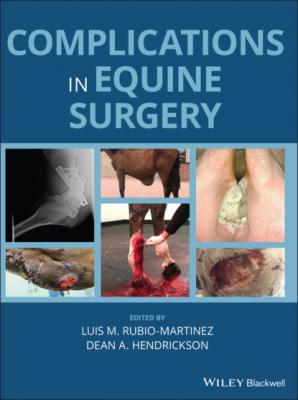Complications in Equine Surgery. Группа авторов
Читать онлайн.| Название | Complications in Equine Surgery |
|---|---|
| Автор произведения | Группа авторов |
| Жанр | Биология |
| Серия | |
| Издательство | Биология |
| Год выпуска | 0 |
| isbn | 9781119190158 |
When using contact circulation probes for limbal squamous cell carcinomas, freezing occurs very fast and should be stopped when the frozen area exceeds 2–3 mm beyond the visible tumor margins. Detachment of the probe is then needed to stop further cooling down of the tissues. This can be achieved by applying 10–20 ml of saline solution at body temperature to the eye [5] . Once the probe is detached, the tumor is further allowed to thaw slowly.
Diagnosis
Diagnosis can commonly not be made within the first days after cryosurgery and the presence of oedema in the tissues to be preserved does not mean that they will become necrotic. It takes several days (at least 7–10) before demarcation of the necrotic tissue becomes evident and before a correct diagnosis of the extent of undesired tissue damage can be made.
Treatment
The necrotic tissue should be removed once it is demarcated (2–4 weeks after cryosurgery) to support second‐intention wound healing. In the case of joint or sheath penetration, standard wound care should be combined with repeated flushing of the synovial cavity and the standard management of a septic synovitis [24]. However, the prognosis is very guarded because of the loss of synovial capsule as a result of tissue necrosis. When globe perforation occurs as a result of cryosurgery, enucleation is the only treatment option.
Expected outcome
Necrosis of the joint capsule can result in a penetrating intra‐articular wound and subsequent joint sepsis which can be extremely difficult to manage and may lead to the destruction of the horse [14, 16]. However, even when the excessive slough of tissue does not result in joint penetration, extensive damage to the periarticular tissues, fibrous reactions and osseous peri‐articular new‐bone formation may occur, resulting in functional impairment and/or osteoarthritis (Figure 11.4). Similarly, necrosis of the tendon sheath wall can result in a penetrating intrasynovial wound and sheath sepsis.
Cryosurgery of periocular sarcoids can result in loss of the upper eyelid, unacceptable scarring of the eyelids, evisceration of the globe, and permanent loss of vision [14, 25].
Freezing of underlying nerves results in loss of nerve function, which can however be reversible. When peripheral nerves are frozen, the cellular components are destroyed but the fibrous part of the epineurium remains intact and will allow regeneration [13]. However, regeneration can also be incomplete [14].
Figure 11.4 (a) Excessive tissue necrosis occurring at the dorsal aspect of the pastern 8 days after cryosurgery for an equine sarcoid. The horse developed lymphangitis of the treated limbs in the first week after cryosurgery. On this picture, sloughing of a very large portion of the skin of the dorsal pastern has started. The wound eventually healed after a skin grafting procedure performed 40 days after the initial cryosurgery. Source: Ann Martens. (b) Lateromedial radiograph of the affected limb 7 months after cryosurgery. Although no penetration of the pastern joint occurred, tissue necrosis resulted in the development of extensive peri‐articular new‐bone formation and associated lameness.
Source: Ann Martens.
Freezing cortical bone causes cell destruction which reduces its strength. Spontaneous fractures have been reported months after cryosurgery [15]. The author has never experienced this complication, which might have been more common at the time cryotherapy was still indicated for the treatment of bony disorders such as fractured splint bones [2].
At locations with mainly underlying muscle, too extensive freezing mainly results in the sloughing of too large a portion of the surrounding skin, subcutaneous tissue and muscle, resulting in a large hole and a subsequent prolonged healing by second intention (Figure 11.5). Functional impairment is almost never an issue is these cases.
Late Postoperative Complications
Tumor Recurrence
Definition
Regrowth of the tumor at the site that was treated with cryosurgery
Risk factors
Large tumors
Tumors with ill‐delineated margins
Size of initial tumor (squamous cell carcinoma)
Figure 11.5 Very extensive slough of skin after cryosurgery of an equine sarcoid at the level of the chest. The largest portion of the cryonecrotic eschar has already been excised and the formation of granulation tissue has started. At this location, this is only a minor complication due to the absence of important underlying structures. The wound will heal by second intention.
Source: Ann Martens.
Pathogenesis
Tumor recurrence occurs when the lesion has not been entirely and/or sufficiently frozen.
To ensure destruction of all tumoral cells, the obtained tissue temperature should be low enough over the entire volume of tumoral tissue (see Intraoperative Complication: Correct Cryosurgical Technique above).
Clinically, it has been shown that the risk of recurrence of limbal squamous cell carcinomas after cryosurgery is significantly influenced by the size of the initial tumor [5]. However, in another study, no significant correlation between recurrence and tumor or patient characteristics was found [4].
Diagnosis and monitoring
Tumor regrowth usually takes several weeks to develop and initially it may be difficult to differentiate new tumoral tissue from young irregular granulation tissue in the cryosurgical wound healing by second intention. The definitive diagnosis of tumor recurrence is made by histopathological analysis of a tissue sample. For equine sarcoids treated by cryosurgery, diagnosis of recurrence is facilitated by BPV‐DNA analysis of a superficial swab of the suspected tissue [26].
Prevention
Correct choice of cryogen and cryosurgical equipment to allow sufficient fast and deep freezing of the tumoral tissue (see above).
Correct cryosurgical technique including the use of a thermocouple needle to monitor tissue temperature in and around the lesion (see above). To ensure freezing of the entire tumor, an appropriate margin of visibly normal tissue should be included. In more
